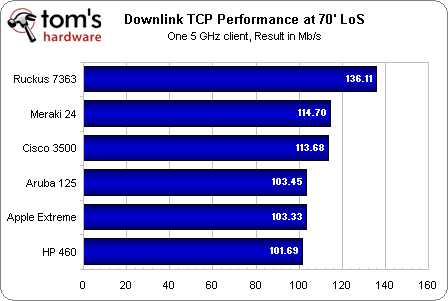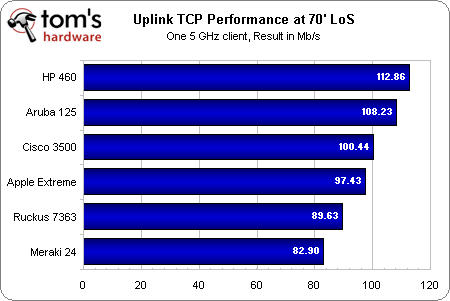Why Your Wi-Fi Sucks And How It Can Be Helped, Part 2
In Part 1, we explained what can go wrong with Wi-Fi signals and how access points can work to improve your wireless performance. It's time for a reality check. We throw six contenders against 65 clients and some hellish interference. Who's left standing?
Benchmark Results: Mid-Range, No Interference
Does it need to be said that anything over 100 Mb/s is a very respectable result for 802.11n? Still, we have a roughly 30% variance from low (HP) to high (Ruckus) here, so obviously something is afoot if both three-stream APs are trailing the two-stream Ruckus. Meraki puts on a good show in second place, but HP now comes in last. This may be a case of the AP’s inability to maintain all three diverse streams.
Imagine standing in an open field trying to run three streams with spatial multiplexing. It wouldn’t work, right? There’s nothing to bounce those secondary signals off of. The only stream available is the direct line-of-sight between the AP and client. To some degree, that principle may be influencing these results. If the HP can’t effectively utilize the nearby walls and other objects to sustain three reliable streams, then it may have to drop down to two streams, or even one (we suspect two in this case). Meanwhile, the difference between 10 feet and 70 is huge for Ruckus, which can now bring its arsenal of transmit/receive options to bear on the current conditions. Again, note Cisco’s 10% boost here over the herd with only two streams.
Here’s some definite weirdness. While it’s not unusual for uplink speeds to trail downlinks, both Aruba and HP show improvements. We haven’t ruled out some sort of fluke sweet spot that affected both APs, but the odds of this explanation being correct seem small.
We should also inquire about the more than 45 Mb/s difference between Ruckus’s uplink and downlink speeds. Most likely, the answer lies in the nature of beamforming. Beamforming has to do with transmitting, not receiving. The beamforming access point can control how it sends out signals, but it has no control over how signals send from the client device.
Said differently, you can cup your hands behind your ears, but you can’t tell someone else how loudly to talk or whether to make a tube out of their hands. At the beginning of part 1, we mentioned the radical difference it made when we switched a netbook from a Cisco 802.11n dongle and AP to a Ruckus Wi-Fi bridge. Part of the reason for this is because both sides of the wireless connection were using the same adaptive technology. Both adapters were using all of those spatial multiplexing, polarization, and other tricks (not to mention working on 5 GHz rather than 2.4 GHz) to get an optimal connection in both directions. Obviously, though, we had to settle on a single client adapter that would best represent what people would be using in an average high-demand environment.
Get Tom's Hardware's best news and in-depth reviews, straight to your inbox.
Current page: Benchmark Results: Mid-Range, No Interference
Prev Page Benchmark Results: Close Range, No Interference Next Page Benchmark Results: Mid-Range, 1 Versus 60 Clients
